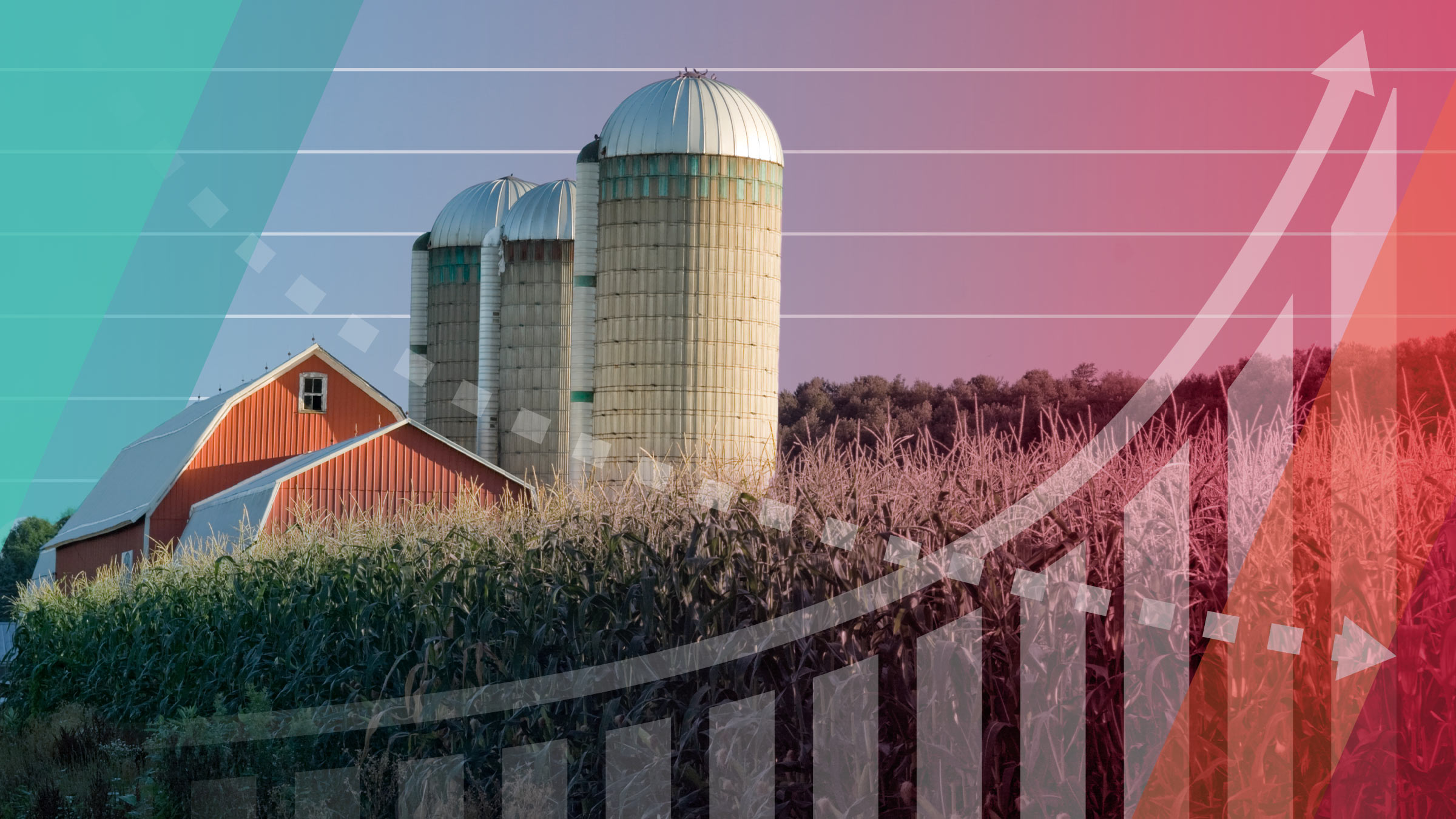Average interest rates for operating loans have increased over 400 basis points since the third quarter of 2021. Higher cost of borrowing impacts all agricultural producers who leverage debt to fund operations and make investments. Higher interest rates, however, will not impact agricultural producers equally. The more financially leveraged an agricultural operation is, the more sensitive the operation is to interest rate increases. This second article in a series on interest rates discusses how agricultural producers who are highly leveraged will face higher interest expenses when their short-term loans reprice. Longer-term implications include decreased debt repayment capacity, increased carryover debt, and reduced equity.
What is financial leverage?
Financial leverage occurs when an agricultural producer borrows funds for their operation. Producers use financial leverage for a variety of reasons, from financing ongoing operations to funding capital improvements. Agricultural producers have varying degrees of financial leverage because of differences in operations, growth strategy, and risk appetite. The most common way to measure financial leverage is by calculating the assets funded with debt obligations, known as the debt-to-asset (DTA) ratio, expressed as a percent. A highly leveraged producer has a DTA ratio greater than 60 percent. The higher the ratio, the greater the financial risk exposure to the operation.
More leverage, more interest expense
Highly leveraged agricultural producers are more sensitive to rising interest rates because they have more debt for their operation.1 As a result, highly leveraged producers have far more total interest expense as a dollar amount compared with the least-leveraged producer (Figure 1). Additionally, highly leveraged producers spend more of their gross revenue on interest expenses (Figure 2). The most-leveraged producers have an interest expense ratio that is over eight times higher than the least leveraged (1.0 percent versus 8.4 percent).
In 2023, interest rates increased, production loan volume increased, and estimates indicate that farm income declined. These scenarios indicate that interest expenses will increase in 2024, while declining farm income will weaken producers’ capacity to repay debt timely.
High interest rates may lead to carryover debt
Debt coverage ratio is the measure of an ag borrower’s ability to make debt payments. Increasing interest expense and declining farm income reduces the agricultural producer’s ability to service existing farm debt. If a borrower’s annual debt repayment capacity is less than their debt payments, they will likely have carryover debt for that operating season.2
As farm income declined from 2015 to 2019, carryover debt increased for highly leveraged agricultural producers. During this period, highly leveraged producers had higher debt payments than repayment capacities, which equates to a debt coverage ratio of less than 1.0 (Figure 3).3 To cover repayment shortages, these producers had to take on carryover debt. Banks may require additional collateral for carryover debt, further weakening these borrowers’ debt coverage ratios.
Borrowers faced higher production expenses and lower commodity prices in 2023. Reduced margins pressured borrower cash flow and significantly reduced debt coverage ratios at year end. All borrowers had notable declines in their debt coverage ratio and are approaching levels the sector saw in the 2015–2019 period (Figure 3).
Pledging equity—not easy for the highly leveraged
During prolonged periods of weak or negative income, an agricultural producer will exhaust current assets before turning to other forms of long-term equity, typically farmland. Farmland equity is the last measure of financial resiliency for a producer. If a producer experiences prolonged financial hardship, they can pledge farmland equity as collateral to fund operations. Low-leverage producers can easily do this because they have more equity per farmed acre (Figure 4).
Highly leveraged agricultural producers, on the other hand, have far less equity per farmed acre. In 2023, these producers had less than 10 percent of the equity per farmed acre compared with least-leveraged producers ($443 versus $7,400). Highly leveraged producers have far less equity to use during prolonged periods of financial hardship, making them far less resilient than their low-leveraged counterparts. The small equity cushion limits the length of time that these producers can leverage their equity for funding operations.
Reducing leverage
Reducing financial leverage is difficult in the agricultural industry—it requires financial restraint, maximizing revenue, and careful planning over a long period of time. Analyzing characteristics of agricultural producers with low debt levels can provide some insight on how highly leveraged producers can improve their leverage position (Figure 5). The following characteristics are notable for low-leverage producers:
- Own most of the farmland in the operation.
- Have very little long-term debt.
- Have low and stable operating expenses.
- Have strong market and operational knowledge, which they incorporate into multiyear plans.
| Low | High | |
|---|---|---|
| Average debt-to-asset ratio | 15.0% | 92.0% |
| Percent of farmed acres owned | 54.0% | 21.9% |
| Long-term liabilities | $92,330 | $981,149 |
| Operating expenses to gross revenue | 78.7% | 91.8% |
| Production years | 30.1 | 13.8 |
Conclusion
Agriculture is capital intensive, often requiring significant financial leverage to acquire land, machinery, or make improvements. Periods of strong farm income can mask weak debt coverage ratios, putting a highly leveraged producer in a vulnerable financial position when income weakens.
Becoming a low-leverage agricultural producer is a deliberate and long-term financial commitment, regardless of farm income cycles. The commitment requires a strategic and consistent approach to leveraging debt, managing expenses, and capitalizing favorable market swings. These prudent financial decisions over time culminate into resilient financial performance during periods of prolonged stress in the agricultural economy.
Endnotes
1 Highly leveraged farms have a DTA ratio greater than 60 percent. These farms tend to have more debt on an absolute basis (total dollar amount of debt) as well as comparatively for size of the operation (debt per acre).
2 SR 11-14 Supervisory Expectation for Risk Management of Agricultural Credit Risk, October 26, 2011. Carryover debt is usually an outstanding line of credit balance that is the result of a borrower’s inability to generate sufficient cash flow from sales to repay the current cycle’s production debt.
3 According to the Farm Financial Scorecard, a strong debt coverage ratio (above 1.75) indicates that there are enough operational funds to make debt payments. A weak ratio (below 1.25) indicates that an ag operation is in a vulnerable repayment capacity position and may not be able to pay off debts or may require additional funding from a lender.






